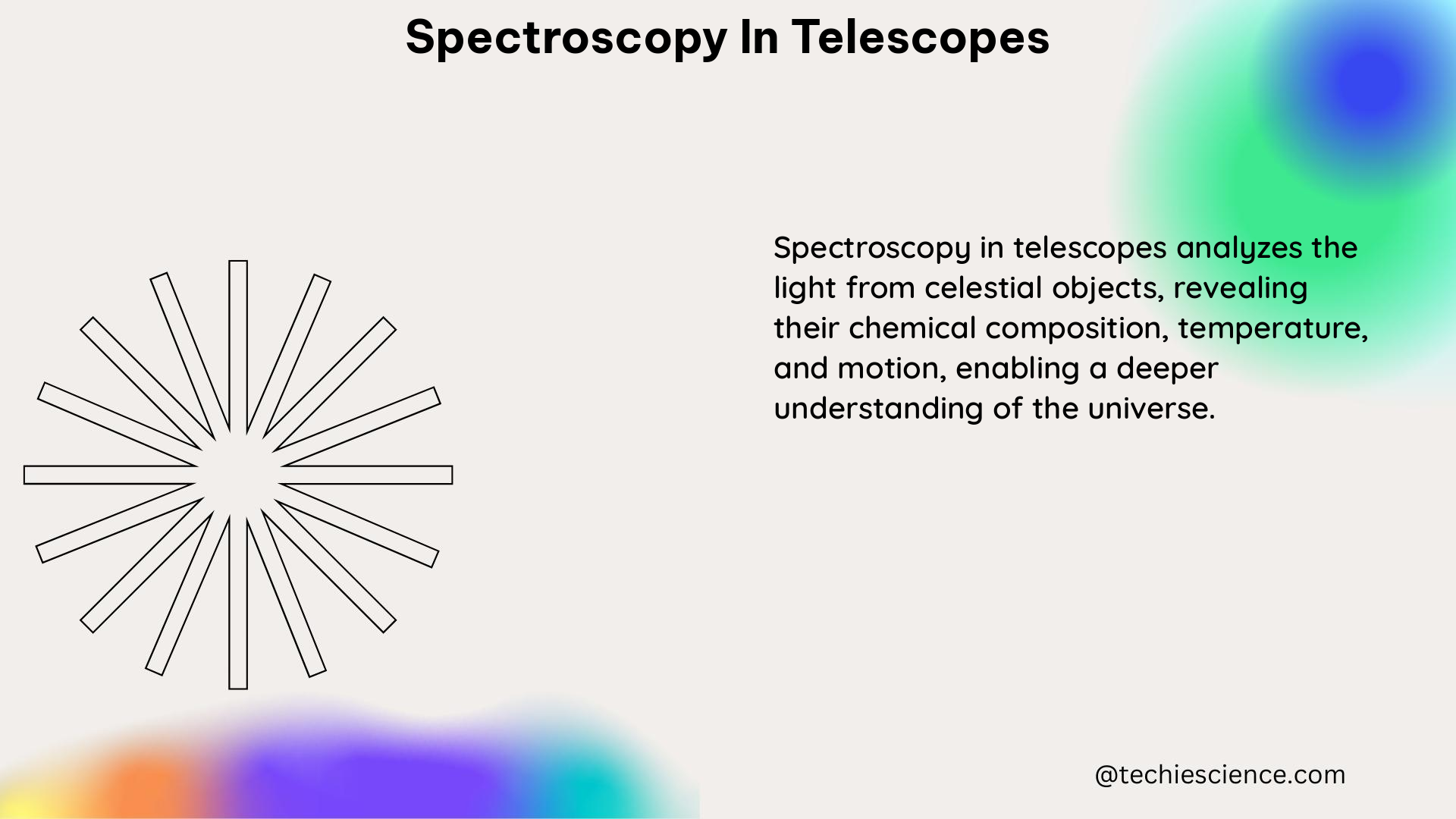Spectroscopy in telescopes is a powerful tool used to study the universe by measuring the chemical compositions, physical properties, and radial velocities of astronomical sources. This comprehensive guide delves into the technical details of spectroscopy, providing physics students with a hands-on understanding of the principles, parameters, and techniques involved in this field.
Understanding Resolving Power
The resolving power of a spectrograph is a crucial parameter that determines the level of detail it can provide. The resolving power is given by the equation:
R = 2 * b * tan θ_i * D / tan θ_s * b
Where:
– b = collimated beam diameter
– θ_i = incident angle
– D = telescope diameter
– θ_s = angle of dispersion
In astronomical spectroscopy, the resolving power is often quantified using the full width at half maximum (FWHM) of the spectral lines. However, this method has limitations as it does not take into account the variation among different line spread function (LSF) forms and their impact on the accuracy of wavelength measurement and the disturbance caused to a near neighbor.
To address this issue, a more consistent definition of resolving power has been proposed, which takes into account the disturbance caused to a near neighbor and the accuracy of wavelength measurement. The proposed definition results in scaling factors that can be applied to bring resolving power calculated using the FWHM into better precision.
Types of Spectrographs

In addition to resolving power, other important parameters in astronomical spectroscopy include the type of spectrograph, the wavelength coverage, the spectral resolution, and the observing and reduction techniques. Different types of spectrographs include:
- Long-slit Spectrographs:
- Advantages: Provide spatial information along the slit, allowing for the study of extended sources.
-
Limitations: Limited wavelength coverage and lower spectral resolution compared to other types.
-
Echelle Spectrographs:
- Advantages: Offer high spectral resolution and wide wavelength coverage.
-
Limitations: Complex optical design and require careful calibration.
-
Fiber-fed Spectrographs:
- Advantages: Flexible and efficient in coupling light from multiple sources.
- Limitations: Potential for light loss and lower spectral resolution compared to slit-based spectrographs.
Observing and Reduction Techniques
Observing and reduction techniques play a crucial role in obtaining high-quality spectra. Standard practices such as flat-fielding, which involve taking images of a flat surface to correct for pixel-to-pixel sensitivity variations, can sometimes degrade the quality of the data rather than improve it. Therefore, careful consideration of calibration needs and reduction techniques is essential for obtaining useful spectra.
Some key observing and reduction techniques include:
- Flat-fielding:
- Purpose: Correct for pixel-to-pixel sensitivity variations.
-
Potential Pitfalls: Improper flat-fielding can degrade data quality.
-
Wavelength Calibration:
- Importance: Accurate wavelength calibration is crucial for precise measurements.
-
Techniques: Using emission line lamps or telluric absorption features.
-
Background Subtraction:
- Necessity: Removing the contribution of sky background and other sources.
-
Techniques: Using dedicated sky exposures or modeling the background.
-
Cosmic Ray Removal:
- Importance: Mitigating the impact of cosmic ray hits on the detector.
-
Techniques: Using algorithms like L.A.Cosmic or median filtering.
-
Flux Calibration:
- Purpose: Converting the observed counts to physical flux units.
- Techniques: Observing standard stars with known spectral energy distributions.
Advanced Spectroscopic Techniques
Beyond the basic principles and techniques, there are several advanced spectroscopic methods that can provide even more detailed information about astronomical sources:
- High-resolution Spectroscopy:
- Achievable Resolving Power: Up to R ~ 100,000 or more.
-
Applications: Studying stellar atmospheres, exoplanet characterization, and precise radial velocity measurements.
-
Integral Field Spectroscopy:
- Concept: Simultaneous spatial and spectral information.
- Instruments: Integral Field Units (IFUs) like MUSE on the VLT.
-
Applications: Mapping the properties of extended sources like galaxies.
-
Polarimetric Spectroscopy:
- Principle: Measuring the polarization state of light.
-
Applications: Probing magnetic fields, dust properties, and the geometry of astronomical sources.
-
Time-resolved Spectroscopy:
- Objective: Studying the temporal evolution of spectral features.
- Techniques: High-speed spectroscopy, spectro-astrometry.
- Applications: Investigating transient phenomena, pulsating stars, and accretion processes.
By understanding these advanced techniques, physics students can explore the cutting edge of astronomical spectroscopy and contribute to the ongoing exploration of the universe.
Conclusion
Spectroscopy in telescopes is a complex and multifaceted field that requires a deep understanding of both the theoretical and practical aspects. This guide has provided a comprehensive overview of the key parameters, types of spectrographs, and observing and reduction techniques involved in this field. By mastering these concepts, physics students can unlock the full potential of spectroscopy in their pursuit of understanding the cosmos.
References
- Massey, P., & Hanson, M. M. (2013). Astronomical Spectroscopy. In Fiber Optics in Astronomy III, ASCP Conf. Ser. 152, ed. S/ Arribas, E., Mediavilla, & F. Watson (San Francisco: ASP), 60.
- Blair, W. P. (n.d.). Spectroscopy as a Tool. Retrieved from https://blair.pha.jhu.edu/spectroscopy/tool.html
- O’Gorman, E. (2013). Quantifying Resolving Power in Astronomical Spectra. Publications of the Astronomical Society of Australia, 30(4), 381–391. https://doi.org/10.1017/pasa.2013.39
- Filippenko, A. V. (1982). The Importance of Atmospheric Differential Refraction in Spectrophotometry. Publications of the Astronomical Society of the Pacific, 94, 715. https://doi.org/10.1086/131052
- Sánchez, S. F. (2006). Integral Field Spectroscopy: A Comparison of Methods and a New Fully Phase-Delay Corrected Approach. Publications of the Astronomical Society of the Pacific, 118(842), 617–634. https://doi.org/10.1086/503363

The lambdageeks.com Core SME Team is a group of experienced subject matter experts from diverse scientific and technical fields including Physics, Chemistry, Technology,Electronics & Electrical Engineering, Automotive, Mechanical Engineering. Our team collaborates to create high-quality, well-researched articles on a wide range of science and technology topics for the lambdageeks.com website.
All Our Senior SME are having more than 7 Years of experience in the respective fields . They are either Working Industry Professionals or assocaited With different Universities. Refer Our Authors Page to get to know About our Core SMEs.